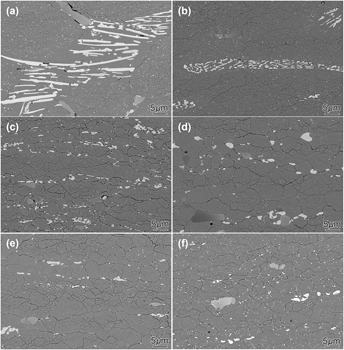Published online by Cambridge University Press: 13 January 2016

The microstructural evolution of spray-formed high speed steel during hot deformation was investigated as well as the effects of spray forming parameters on the porosity formation. Four distinct zones are identified in the as-deposited material, and interstitial porosity is present in the bottom and peripheral zones, while gas-related porosity is mainly found in the central zone. It can keep the porosity at a minimum value by using the optimum parameters, e.g., the average porosity of central zone is 3.7% for a superheat of 170 °C and a gas-to-metal flow rate of 0.7. During hot deformation at 1150 °C, the amount of porosity can be obviously decreased by increasing the height reduction which also plays a key role in breaking up eutectic carbides. The critical height reduction for the breakdown of the eutectic carbides is 50%, the dominant mechanism being mechanical fragmentation.